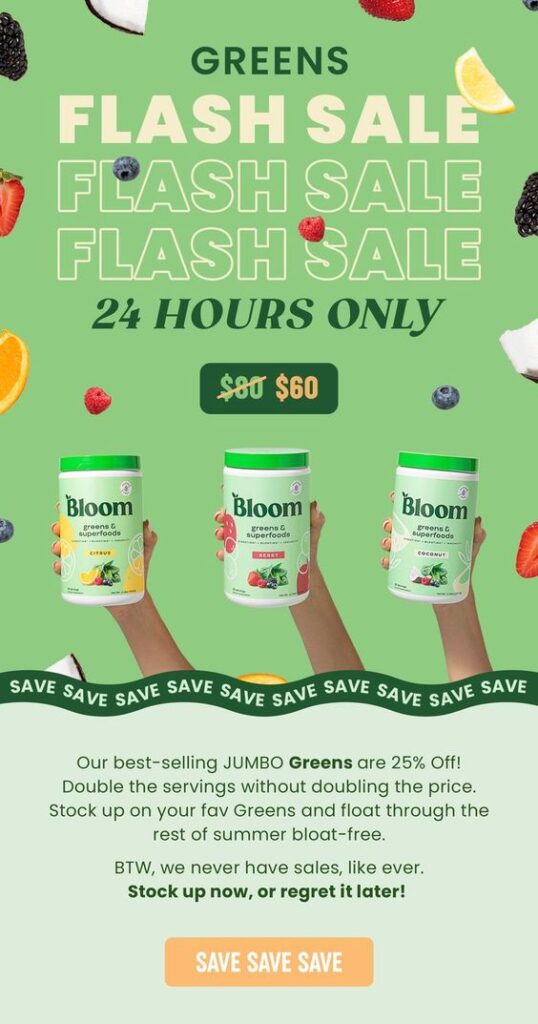It’s no secret that email is one of the most powerful marketing tools available today. To this note, lead-nurturing emails can boost conversions and sales by offering valuable information to prospects and gently nudging them to make a purchase decision.
It’s undoubtedly an email marketing strategy that you wouldn’t want to overlook.
In this article, we’ll show you how you can create effective lead-nurturing emails. We’ll also share practical examples that can inspire your next campaign.
First, let’s understand the basics of lead nurturing and how to leverage this email marketing strategy to benefit your business.
What is lead nurturing?
To put it simply, lead nurturing refers to the strategic marketing process of converting prospects, known as leads, into customers.
It usually involves several key stages. It begins with educating leads and building brand awareness, then nurturing interest by providing educational content and personalization.
The last step is converting the leads to customers by demonstrating how your brand addresses their pain points.
Typically, lead nurturing occurs during the middle stages of the sales funnel. Here, leads have shown interest in your products but aren’t ready to buy from you yet.
Benefits of email in lead nurturing
By sending tailored messages to individual leads based on their interactions with your brand, you can actively stay in touch with them and build a strong relationship. However, there’s more to lead nurturing than this.
Let’s explore other benefits of email lead nurturing:
- Improves conversion rates: A good nurturing email addresses the leads’ concerns and offers timely information. This can encourage them to take action, such as making a purchase.
- Enhances brand awareness: Sending lead-nurturing emails regularly will keep your brand at the top of consumers’ minds, even if leads aren’t ready to buy from you yet. This consistent exposure can build awareness and position your brand as a reliable solution.
- Reduces marketing costs: Email lead nurturing allows for scalable communication without the high costs that you’d normally see with social media and PPC advertising.
This will help you position your brand more effectively in the market. It will also allow you to create more targeted, highly converting emails.
Components of a successful lead-nurturing email campaign
There’s no doubt that lead nurturing is beneficial. According to Invespcro, well-nurtured leads tend to make 47% more purchases than those not nurtured.
However, what does a well-crafted lead-nurturing email look like? Here are nine key components you should remember.
Clear and compelling subject lines
A clear and catchy subject line instantly grabs the attention of your leads, prompting them to open the email and check out what you have to offer.
Consider the following key tips to make your subject line more compelling:
- Keep it concise
- Add a sense of urgency and FOMO with words like “Don’t Miss Out”
- Highlight the benefits of opening the email
Personalized greetings and email content
When it comes to lead-nurturing email marketing, personalization is key. It shows your leads that you’re interested in connecting with them on a deeper level.
Some ways to personalize your lead-nurturing emails include:
- Addressing your leads by their names
- Tailoring the email copy to address their pain points and interests
- Sending emails at times when they’re most likely to engage
Value-driven content
When people subscribe to an email list, they often seek value in return. This value could be in the form of:
- Personalized recommendations
- Educational content
- Exclusive access and offers
By consistently offering helpful resources to your leads, you’re more likely to increase engagement and conversions. For example, you can provide reports, webinars, free courses, blogs, and e-books.
Clear calls-to-action (CTAs)
Adding a clear and compelling CTA button to your lead-nurturing emails is the easiest way to encourage your leads to take the desired action.
You can maximize the impact of your CTA by:
- Using contrasting colors, bold fonts, or eye-catching buttons to make it stand out
- Using action-oriented language to increase conversions
- Adding multiple CTA buttons to specific landing pages to increase visibility
This welcome email by Kick Game highlights the benefits of connecting with the brand. It also contains multiple CTA buttons to facilitate effortless shopping.

Image via Really Good Emails
Engaging visuals
Adding visuals to your emails can help you capture your leads’ attention and communicate your message quickly.
Here are some tips on how to optimize visuals and media to nurture your leads:
- Use high-resolution images that are compatible with all devices
- Use consistent, branded images and your style in every email
- Share tutorials, behind-the-scenes videos, and testimonials to enhance your credibility
Trust-building elements
Trust is the cornerstone that converts resistant leads to customers. Trust-building elements in your emails can help reinforce your credibility and assure leads that you’re reliable.
Here are a few tips for adding trust-building elements to your emails:
- Showcase reviews, ratings, and testimonials from satisfied customers
- Display trust signals, such as certifications or awards, in a highly visible area like the footer of your website
- Mention money-back guarantees near purchase-related CTAs
The Canopy email showcases a testimonial from a founder of another popular brand. Such elements in your email will nudge prospects to take your brand more seriously and explore more offerings.

Image via Really Good Emails
Mobile-friendly design
Most users access their emails on mobile devices. That’s why it’s crucial to ensure that your lead-nurturing emails are optimized for mobile viewing.
You can achieve this by:
- Ensuring that your email layout adapts to fit various screen sizes and orientations
- Keeping your texts precise so that the emails are more readable on mobile
- Sizing your images for mobile screens to avoid slow loading times
Timing and frequency optimization
Sending lead-nurturing emails at an optimal time can help maximize your engagement and avoid lead fatigue.
Analyze data and figure out when your leads are most receptive. If, for instance, you discover that emails sent on Monday afternoons consistently have higher opening rates, prioritize sending emails during this time.
You can also let your leads choose their preferred frequency upon signing up for your email list. This can help reduce unsubscribe rates and improve overall engagement. Provide options like daily, weekly, or monthly updates to cater to different preferences.
Six lead-nurturing email examples
Lead-nurturing email campaigns can be very effective. Let’s take a look at these successful lead-nurturing email examples you can emulate to convert your leads:
Welcome email for new subscribers
An effective email lead-nurturing campaign begins with a welcome email. It’s the first message you send to leads after they sign up to your email list or newsletter.
The primary goal of the welcome email is to introduce your brand and set expectations for what they’ll receive by subscribing.
Bleam welcomes its new subscribers with this very informative welcome email. It addresses the common pain points and presents a list of its products as a solution. As promised, it offers a 10% discount with limited validity, nudging users to make a purchase so they don’t miss out.

Image via Really Good Emails
Educational content emails
Educational emails offer valuable information to help your leads solve a problem or learn something new about your product or industry.
They help position your brand as an industry leader and keep leads engaged with helpful content, with the end goal of converting them into buyers.
Educational content could include expert blog posts, how-to guides, whitepapers, webinar links, and product description videos.
Here’s a great example of an educational email. The brand educates the leads while positioning their products as viable solutions, increasing the chances of converting them.

Image via Pinterest
Product updates and announcements email
These emails are an excellent way to keep your leads up-to-date on what’s going on with your company. You could update them about new features, product launches, or improvements to existing services.
This simple yet suitable email by Quip is a good example. It effectively showcases the limited-edition product with a color palette that enhances its visual appeal. A sense of urgency is added to compel the leads to act fast. Lastly, the precise CTA aids easy buying.

Image via Pinterest
Re-engagement email for cold leads
These emails aim to reignite the interest of your inactive or “cold” leads, or “lapse purchasers,” as marketers call them in ecommerce. Their content should be unique and highly engaging to prompt leads to re-connect with your brand.
An effective strategy for your re-engagement email campaign is to include incentives, such as special discounts or offers, to encourage leads to respond fast.
This re-engagement email by Beauty Express is a compelling one. The bold heading and the discount code, ‘MISSYOU’ clearly show the recipient that they’ve been missed. To reignite their interest and encourage a purchase, a temping 20% discount is offered.

Image via Pinterest
Customer testimonial and case study email
These emails highlight real-life examples of how your brand has solved problems or delivered results for your satisfied customers. This can help build credibility and show leads that other people are using your products successfully.
Observe how Surreal has crafted a visually rich email to share positive testimonials. One of their healthy cereals has been well accepted by customers.
To influence new buyers, reviews from satisfied customers are showcased prominently in the email. The customized CTAs entice prospects to try this product.

Image via Really Good Emails
Special offers and exclusive discounts email
Some leads might be hesitant to purchase from your brand because of the price. Offering special offers and discounts motivates them to convert.
These emails create a sense of urgency and encourage leads to take advantage of the discounts or exclusive offers while they last. When timed correctly, they can convert many leads to customers.
Take a look at this flash sale email by Greens. This example is not 100% lead-nurturing example, but definitely worth including into your email marketing strategy. By organising a flash sale and offering a hefty $20 discount on their popular products, Greens invites the users to stock up on their favorites.
The different shades of green, the flowy design, and the imagery add a touch of freshness to the email. Observe how the CTA button emphasizes savings.

Image via Pinterest
Wrap up
By crafting effective lead-nurturing emails, you can build strong relationships, address pain points, and guide leads towards making a buying decision.
Here are key takeaways from this article to keep in mind:
- Every lead nurturing email should provide value. This can be through educational resources, exclusive offers, or product information.
- Trust and credibility matter. Incorporate trust signals like testimonials and reviews to build credibility and reassure leads.
- Use prominent, action-oriented CTAs in your emails. These will guide leads to take your desired action, such as making a purchase or signing up for a free trial.
